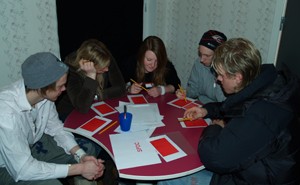For the last two weeks, the Norwegian Burma Committee and the Nobel Peace Center have held role-plays for high school students at the Human rights House in Oslo. The aim of the play was to agree upon how to end the use of child soldiers in Burma. The students truly became their parts: junta generals refusing all allegations; Thailand’s ministers disagreeing among themselves – there were even spies infiltrating the other groups and taping secret negotiations. (20-FEB-06)
This article is written by Marte Graff Jenssen of the Norwegian Burma Committee. It has been edited for republication here by HRH / Niels Jacob Harbitz. All photos: Claire Whelan / The Norwegian Burma Committee.
 Burma is ruled by a brutal military junta which spends more than 40% if the annual budget on the army and uses 450 000 soldiers to control the population and the various different ethnic groups opposing the regime. About 70 000 children are among the soldiers, according to Human Rights Watch, something which equals the highest number of child soldiers in the world.
Burma is ruled by a brutal military junta which spends more than 40% if the annual budget on the army and uses 450 000 soldiers to control the population and the various different ethnic groups opposing the regime. About 70 000 children are among the soldiers, according to Human Rights Watch, something which equals the highest number of child soldiers in the world.
 Before entering into the role-play, the students had learned about negotiating, the situation in Burma in general and when it comes to the use of child soldiers in the different armies in the country. They were divided into five different key players: The junta, the main opposition party NLD, Thailand, UNICEF and one of the many ethnic guerrilla groups in the country, the KNLA. They then studied the arguments of their group, and discussed the strategy they would use throughout the role-play.
Before entering into the role-play, the students had learned about negotiating, the situation in Burma in general and when it comes to the use of child soldiers in the different armies in the country. They were divided into five different key players: The junta, the main opposition party NLD, Thailand, UNICEF and one of the many ethnic guerrilla groups in the country, the KNLA. They then studied the arguments of their group, and discussed the strategy they would use throughout the role-play.
 If the high school students that participated in the role-play at the Human Rights House in Oslo had power to change the situation in Burma, there would for certain not be that many child soldiers in the country! The students came up with various suggestions for how to end the use of children in the civil war. But they also realized just how difficult negotiations between different groups can be, especially if the partners in the process do not even manage to agree upon what the real problem is.
If the high school students that participated in the role-play at the Human Rights House in Oslo had power to change the situation in Burma, there would for certain not be that many child soldiers in the country! The students came up with various suggestions for how to end the use of children in the civil war. But they also realized just how difficult negotiations between different groups can be, especially if the partners in the process do not even manage to agree upon what the real problem is.





